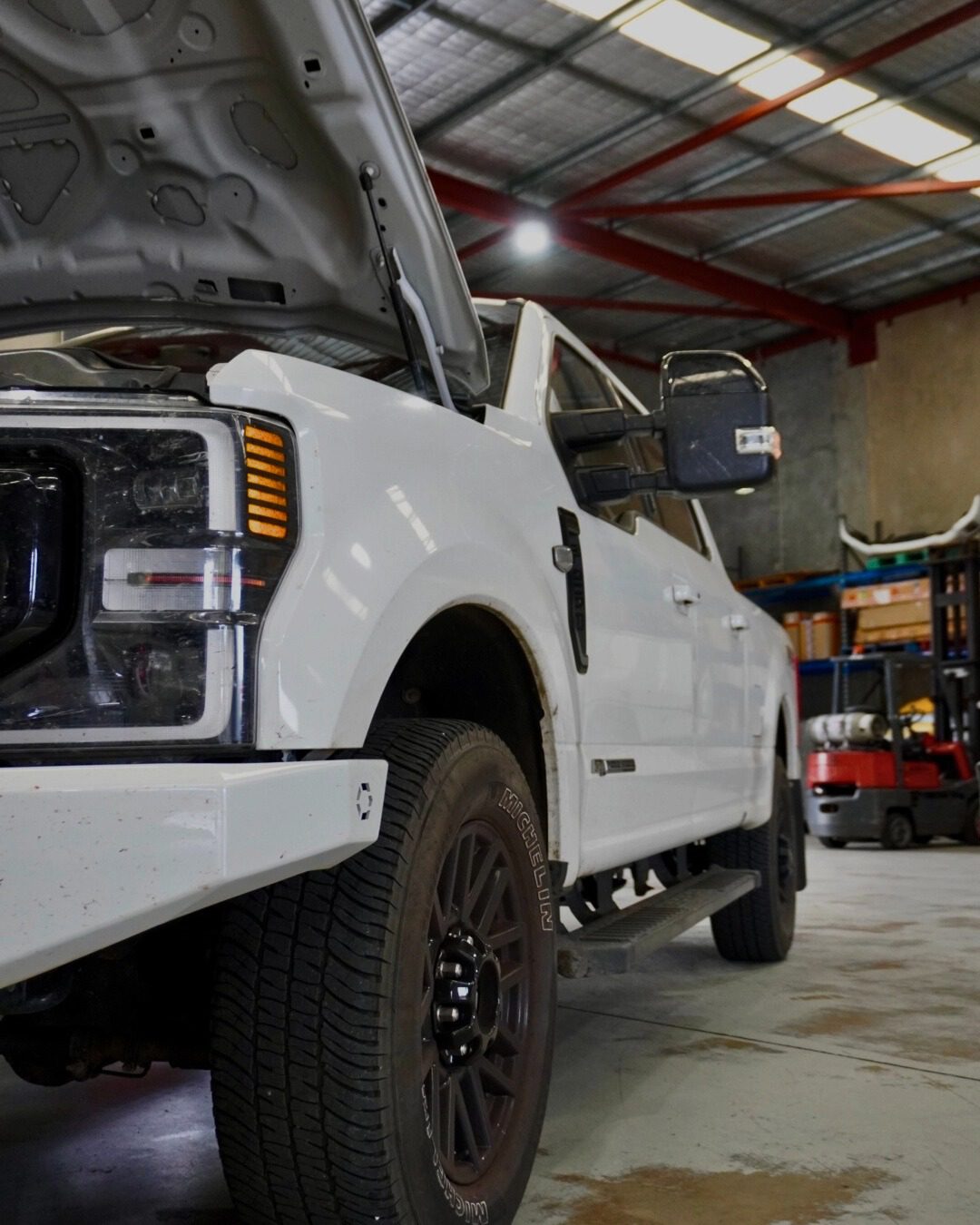Ford trucks have been a symbol of motoring strength and durability for decades, and they’ve become a staple in the lives of many individuals and businesses. Whether you’re a weekend adventurer, a farmer, or a contractor, your Ford truck’s towing capacity is a critical factor to consider when choosing the right vehicle for your needs.
American Ford trucks, like the Ford F-Series, are becoming more popular in Western Australia. These vehicles suit the terrain here in the West, allowing you to haul heavy loads, explore off-road or simply fulfil your dream of having a sleek ride.
Ford trucks are known for their durability and ruggedness. They are designed to handle heavy workloads and demanding conditions, making them suitable for a wide range of applications, from construction and agriculture to daily commuting. The variety of engines, including powerful V8 and turbocharged V6 engines provide the performance and towing capacity that many drivers are now looking for.
Beneficially, Ford trucks typically have high towing and hauling capacities, making them an excellent choice for people who need to tow trailers, boats, or other heavy loads.
Understanding what your Ford truck can handle is not only essential for safety but also for maximising its use.
Let’s explore the concept of towing capacity, how it’s determined, and what you need to know to make the most of your Ford truck’s capabilities.
What Is Towing Capacity?
Towing capacity refers to the maximum weight a vehicle can safely tow. It’s an essential specification to consider, especially when you plan to transport heavy loads, trailers, or other vehicles.
Understanding your Ford truck’s towing capacity is crucial for a variety of reasons:
Safety: Exceeding your truck’s towing capacity can lead to accidents, decreased braking performance, and steering difficulties. It can put your safety and the safety of others on the road at risk.
Legal compliance: Many areas have specific regulations regarding towing capacity, and exceeding these limits can result in fines and penalties.
Mechanical strain: Overloading your truck can lead to premature wear and tear, reducing its lifespan and increasing maintenance costs.
Performance: Towing within your truck’s capacity ensures better control, acceleration, and fuel efficiency, making your journey smoother and more cost-effective.
The Towing Capacity Terms You Need to Know
Towing comes with its own unique terminology and if you are new to vehicles that can tow, this can be intimidating at first. But all the terms come down to simple measurements.
Braked vs. Unbraked Towing Capacity
If your trailer comes equipped with its own brakes, they are connected to the vehicle electrically, so that when you step on the brake pedal, it activates the brakes on both your car and your trailer. A vehicle can often tow a much heavier load if the trailer has its own brakes. This means that braked capacity is higher than unbraked capacity.
Kerb Weight
The kerb weight is the total weight of the vehicle and all the fluids it requires to operate, including a full tank of fuel, but with no people or cargo inside.
Dry Weight
The dry weight is a measurement of how much your Ford truck weighs with no cargo and none of the fluids required to operate your vehicle. You generally do not need to know the dry weight when doing your towing calculations.
GAWR
The gross axle weight rating means the maximum amount of weight one axle can support. This number will almost always show differences between the front and rear axles.
GCWR
The gross combined weight rating, also known as gross combined vehicle weight rating, is the maximum weight your tow vehicle is rated to handle when fully loaded with a trailer and all cargo.
GTW
Gross trailer weight is the total weight of your trailer and its cargo. If you were to place the fully loaded trailer on a scale, the result would be the GTW. If your GTW exceeds your vehicle’s towing capacity, you cannot move it safely. It is crucial that you don’t attempt to tow a GTW higher than your towing capacity as you are likely to damage the tow vehicle, and the trailer, and be unable to control the vehicle properly.
GVWR
The gross vehicle weight rating is the maximum amount of weight a vehicle can hold and includes the weight of the vehicle itself. It takes into account the strength of the frame, suspension, axles, and wheels. Your tow vehicle and the trailer you are using to tow will each have their own GVWR. It’s possible to overload each one separately.
Payload
The payload capacity is the maximum amount of weight a tow vehicle is rated to carry in total. In contrast, towing capacity is the weight limit for any trailer it can pull.
Tongue Weight
Sometimes referred to as TW, the tongue weight is the force pushing down on the trailer hitch by the load being hauled. Tongue weight can change based on how the load gets distributed within the trailer.
Towing Capacity
The towing capacity is the maximum amount of weight it can safely pull.
How Is Towing Capacity Determined?
Towing capacity is determined by a combination of factors, and it’s not solely based on the engine’s power.
There are five main factors that influence the towing capacity of your Ford ute.
Gross Vehicle Weight Rating (GVWR): This is the maximum weight that your truck can safely handle, including its own weight and the weight of passengers and cargo.
Gross Axle Weight Rating (GAWR): GAWR specifies the maximum weight each axle can handle. It’s crucial to consider this when distributing weight, as overloading one axle can lead to imbalanced handling.
Engine Power: A more powerful engine can generally handle heavier loads, but it’s just one piece of the puzzle. Other components like the transmission and brakes play a significant role in determining towing capacity.
Suspension and Chassis: A heavy-duty suspension and chassis can handle more weight and distribute it more evenly.
Towing Package: Some Ford trucks come with optional towing packages that enhance their towing capabilities. These packages may include features like reinforced hitches, larger radiators, and more robust cooling systems.
Understanding Weight Ratings
When towing, it’s important to be aware of various weight ratings to ensure safety and compliance. As well as the Gross Vehicle Weight Rating mentioned above, you need to consider the following three factors.
Gross Combined Weight Rating (GCWR): This is the total weight of your loaded truck and the loaded trailer combined. It should not exceed the GCWR for safe towing.
Tongue Weight: This is the downward force exerted on the hitch ball by the trailer’s coupler. It typically ranges from 10-15% of the trailer’s total weight.
Payload Capacity: This refers to the maximum weight that your truck’s bed or cargo area can handle. It includes passengers and any cargo.
How Do I Know What Towing Capacity I Require?
Determining the towing capacity, you need for your vehicle depends on several factors, including the type of trailer or load you plan to tow. So how do you find out how much towing capacity you need on a day-to-day basis, whether it be for work or leisure?
Firstly, you should consult the owner’s manual that came with your Ford truck. The manual typically provides information on the vehicle’s towing capacity. Look for a section related to towing, which may include weight limits and guidelines for safe towing.
You then need to consider the type of trailer or load that you will be carrying. If you plan on carrying work tools during the week but towing a boat or caravan on the weekends, you need to consider what the gross weight of the trailer or load will be at its maximum, including when it is fully loaded with cargo, water, or any other equipment.
When you are calculating the weight, you need to remember to account for the additional weight of passengers, fuel, and other cargo you might be carrying in your vehicle at the time.
We briefly mentioned the vehicle’s payload capacity previously but if this is your first time purchasing a Ford truck in Perth you might be wondering what exactly that means. Simply put, it is the maximum weight your vehicle can safely carry, including the weight of passengers, cargo and the tongue weight. This weight must not exceed the payload capacity. It is this reason it is important to have an idea of what you will use your vehicle for, before purchasing.
The tongue weight may also be another area you aren’t across, and like the payload weight, it is an important factor in understanding how much you can tow.
The tongue weight is the weight applied to the trailer hitch by the trailer or load. It typically falls within the range of 10% to 15% of the total trailer weight. It is essential that you ensure that the tongue weight is within the recommended range for your vehicle.
Of course, with all weight calculations, you should leave a safety margin – there is very little that is absolute, and towing at or near the maximum of your car’s towing capacity can put extra stress on your vehicle, reducing its stability and control. It is recommended to keep the loaded trailer weight at 80% or less of the vehicle’s total towing capacity to ensure safe and stable towing.
Other factors you should consider include the type of terrain you’ll be driving on, the weather conditions, and whether your vehicle has any additional towing equipment like trailer brakes or a weight-distribution hitch, which can affect towing capacity.
If you’re still uncertain about your vehicle’s towing capacity or need assistance in calculating the towing capacity you need prior to purchasing, the experienced team at F Trucks WA can provide guidance and ensure you’re towing safely and within the vehicle’s capabilities.
You should always prioritise safety when towing and adhere to local laws and regulations regarding towing weights and equipment. Overloading your vehicle can lead to accidents and damage to your vehicle, so it’s essential to choose the appropriate towing capacity for your specific needs.
Where to Find Your Ford Truck’s Towing Capacity
Your Ford truck’s towing capacity can typically be found in several places:
Owner’s Manual: The owner’s manual that comes with your vehicle provides detailed information about its towing capacity.
Ford’s Official Website: You can visit the Ford website and use their vehicle configurator or search for your vehicle’s specific model and year to find towing capacity information.
Consult a Ford Dealer: You can also consult a Ford dealership or speak with a sales representative who can provide information about your truck’s towing capacity. If this is an important factor for you, it should be discussed in depth with the sales consultant prior to purchase.
Are you looking to buy a new Ford truck? Or need to have your current ride serviced? Our passionate team understands the unique demands of Western Australia’s terrain and delivers tailored solutions to meet your trucking requirements. Trust F Trucks WA to provide exceptional American trucks backed by reliable service, genuine parts, and unrivalled expertise.




